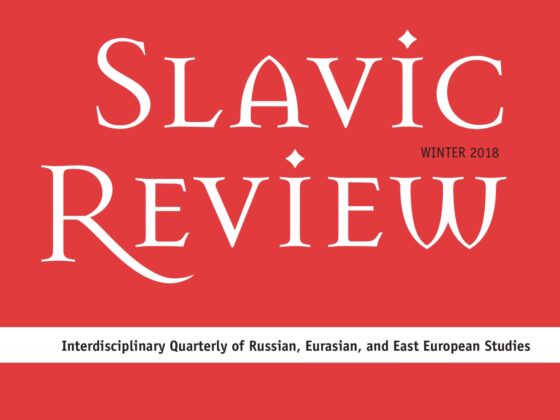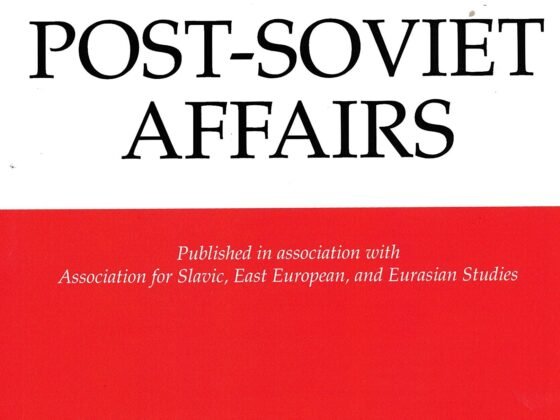There are 193 states that are members of the United Nations, but sovereignty in some of them is contested by de facto states, anti-regime guerillas, and stateless nationalist movements. De facto states differ from anti-regime guerillas who control territory because they seek self-determination from their “parent state.” They also differ from stateless nationalist movements because they have achieved de facto statehood. Such entities violate the principle of territorial integrity in multiple ways and want to modify the borders of the contemporary state system. To begin with, de facto states directly affect their parent states whose sovereignty they challenge. Moreover, these areas of “limited statehood,” as Berlin-based scholar Thomas Risse would put it, unsettle the international system of states, and can become the source of interstate war. Startlingly, the Islamic State operated as an “unbounded” de facto state motivated by a revisionist ideology seeking to disrupt the entire international system. In this policy memo, I argue that the structure of the international system at any given point in time can account for the patterns of emergence and survival of de facto states. In particular, whether the system is bipolar, unipolar or multipolar can help us understand where de facto states are more or less likely to emerge, and whether they survive or get recognized by a qualifying majority of UN member states.
Mapping De Facto States: Cold War vs. Post-Cold War
Building mostly on University of Glasgow professor Adrian Florea’s recent work, we can identify 25 de facto states that survive today, while more than ten have disappeared since 1945 (e.g., Katanga, Biafra, Krajina, Chechnya, Anjouan, Tamil Eelam, Rwenzururu Kingdom, Găgăuzia, Bougainville, Eastern Slavonia, Aceh). Only three have managed to become recognized states and UN members (Eritrea, East Timor, South Sudan). Map 1 depicts all of the parent states that have faced de facto states since the end of World War II.[1] Looking at the map, it becomes clear that North and South America, as well as Western Europe, have been quite immune to de facto states following World War II. If we take a closer look at the distribution of cases over time, more patterns emerge.
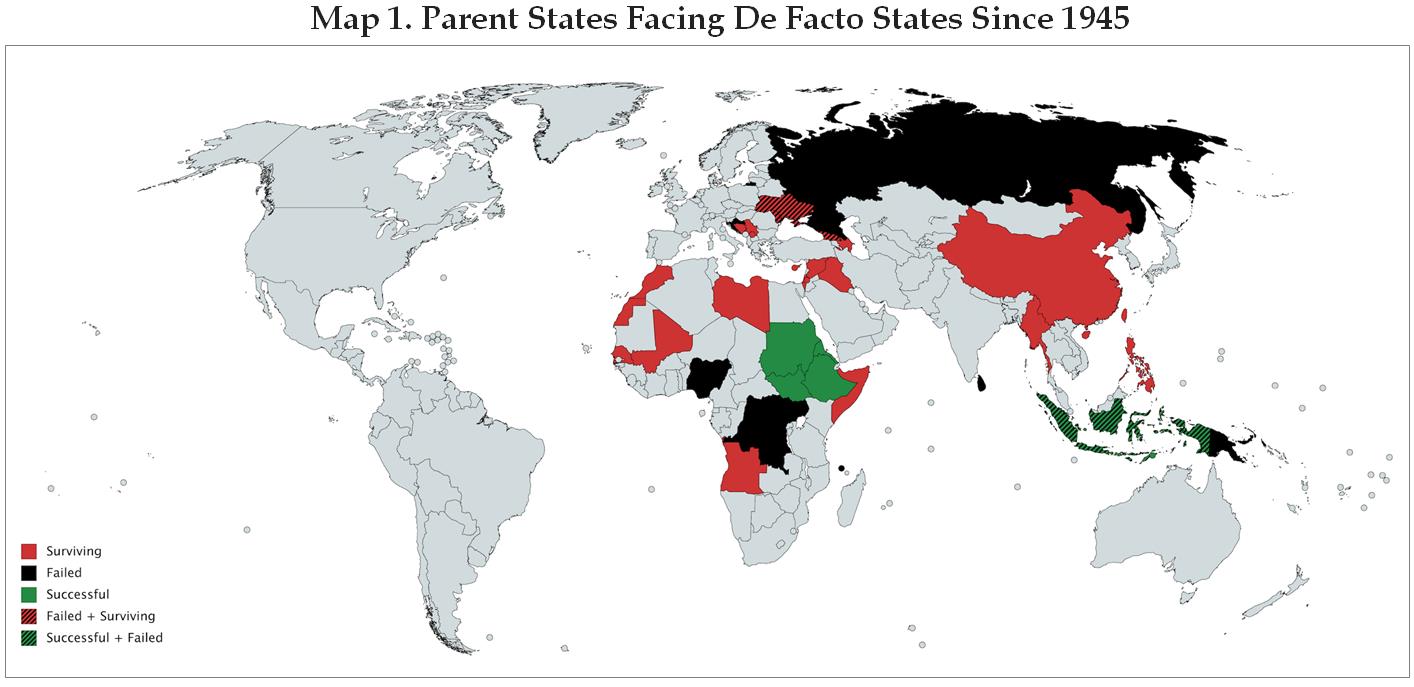
In Map 2, we see all of the states that experienced de facto states within their borders up to the end of the Cold War. It becomes clear that during the Cold War there were no de facto states within NATO or Warsaw Pact members. No such entities developed in either bloc. Almost all of the cases involved states in Africa and East Asia and were often linked to the broader decolonization process.
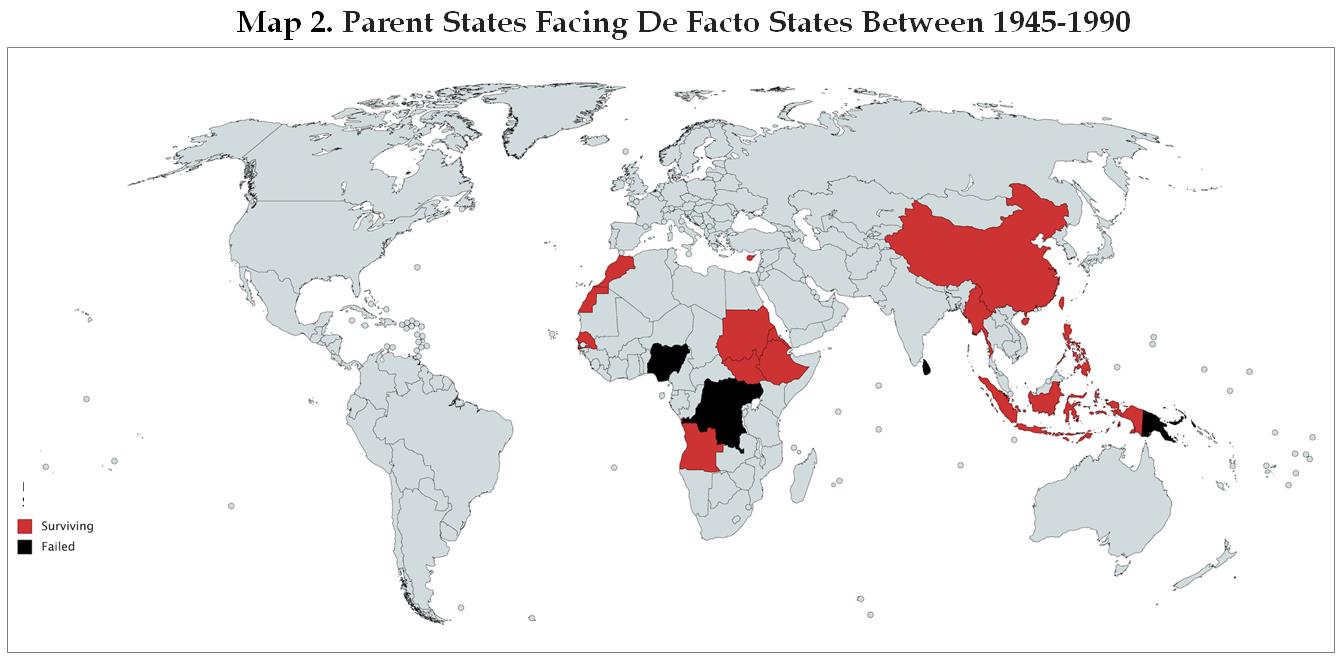
Once the Cold War ended, however, things changed. Map 3 depicts only the parent states that experienced one or more de facto state challengers since 1990. We see that de facto states sprung up primarily in the former USSR, Eastern Europe, and the Middle East. NATO members were still immune. Moreover, the three de facto states which ultimately achieved recognition (Eritrea in 1993, East Timor in 2002, and South Sudan in 2011) all succeeded doing so in the post-Cold War era. Very few of the failed de facto states enjoyed the recognition of any UN member despite the fact that some of them lasted for over 20 years (e.g., Tamil Eelam, Bougainville).
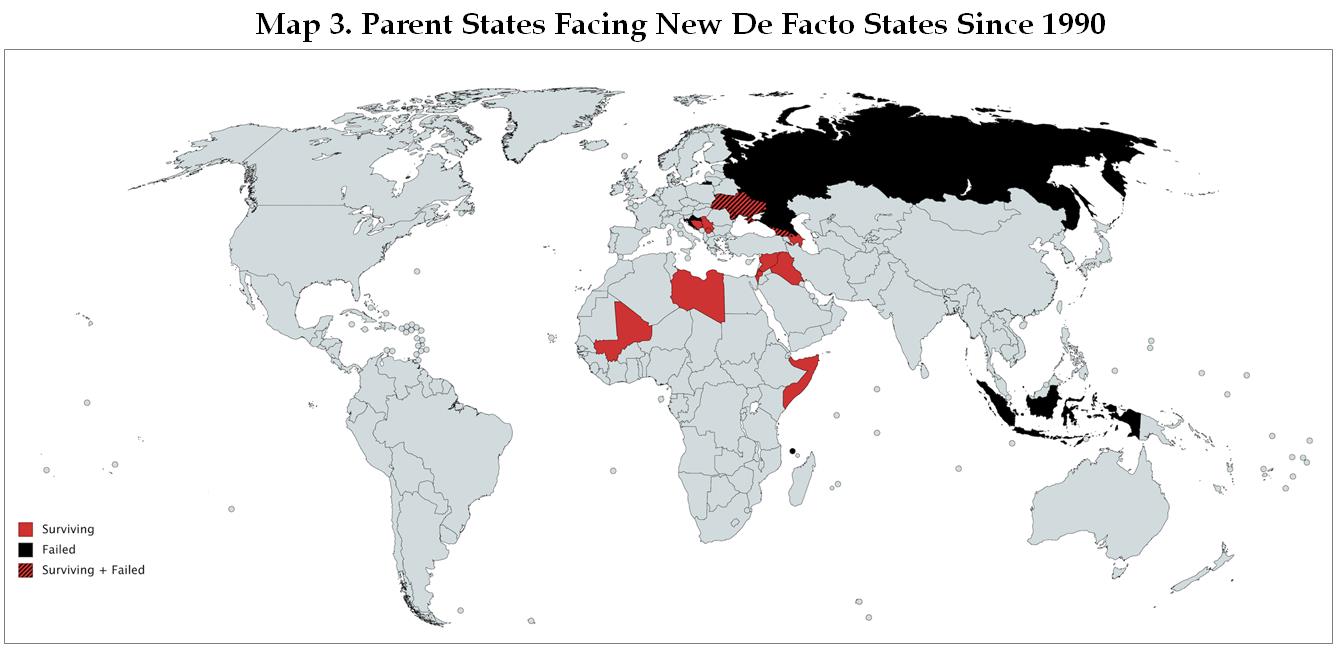
What accounts for these patterns? To answer this question, we must to take a closer look at the ontology of de facto states. We need to understand the role of de facto states in our international system; the decision calculus of the respective external patrons, the elites of de facto states, as well as the governments of the parent states and their external patrons.
Scholars often emphasize that de facto states have control over a given territory but lack international recognition. Adrian Florea defines de facto states as: “separatist entities that exercise a monopoly over the use of violence in a given territory but lack universal recognition.” Similarly, John McGarry, a political scientist from Northern Ireland, writes, “De facto states are a result of a strong secessionist bid, on the one hand, and the unwillingness of the international system to condone secession on the other.” However, most de facto states have control over a given territory only in so far as they enjoy the backing of a particular patron. To be sure, de facto states can and do emerge without external support in weak states. But even in those cases, in order to survive external support becomes critical at some point. As Lancaster University’s Nina Caspersen says, it is “impossible to understand the creation and survival of de facto states without reference to external actors, and the entities are, more often than not, dependent on support from a patron state.” Thus, ironically, de facto states are dependent on external support for survival but also to achieve their ultimate goal: recognition! And while elites in these de facto states have their own agendas, they are more often than not forced to make them compatible with their initial or current external patron.
Given the importance of external support for de facto states, the structure of the international system at any given point in time should have an impact. In particular, in a bipolar system, we should not find any de facto states emerging within the blocs since the hegemon of each pole has incentives to protect its members from external meddling (other than their own). The only instances of de facto states may appear as part of proxy warfare in the periphery of each bloc or in territories where the two blocs are vying for control. The pattern depicted in Map 2 and described above is consistent with this line of reasoning. Once the international system ceased to be bipolar—the “unipolar moment” of the 1990s—we expected NATO members to remain immune and countries belonging to the other pole to be more vulnerable. The pattern revealed on Map 3 is consistent with this expectation. Almost half of the post-Cold War de facto states are the result of “the wars of the Soviet succession.”
But why are some de facto states successful at getting recognized as independent states by the international community (Eritrea, East Timor, South Sudan) while others survive but remain unrecognized for decades (Transnistria, Western Sahara, Northern Cyprus) at the same time that some disappear and get reincorporated into their parent state (Biafra, Chechnya, Aceh)? Looking back into the history of state-making, we can draw several lessons. A lot of the cases of de facto states that disappeared can be explained through the lack of external support and/or overwhelming external support for the parent state. Independence and full recognition were possible either when there was near complete hegemony by a bloc of countries that supported a particular independence movement or when an elaborate spheres-of-influence understanding existed that allowed for “exchanges” between the various major powers and their protectorates.
To be sure, de facto states, just like recognized states, are not all alike. There is a range of de facto statehood. Some de facto states have more agency than others. Turkey practically built a de facto state in Northern Cyprus following the 1974 invasion but has not always controlled internal dynamics there. Some countries are just extensions of existing states. This describes the relationship between Russia and Abkhazia/South Ossetia. For such cases, the status quo may be the best possible—if not desired—outcome for the external patron. On the other extreme, the (rare) case of annexation is still an option in cases where contiguous external patrons make co-ethnicity claims. For instance, we can point to Russia’s recent de facto annexation of Crimea which, as a result, never became a de facto state.
What accounts for this variation? When is it in the interest of an external patron to annex a territory and when to keep the territory as a de facto state? To be sure, whether the external backer’s aim is to destabilize or stabilize a certain region is key to this decision. Counterintuitively, however, if the goal is to create a buffer (de facto) state or to just destabilize a rival, such a de facto state is more likely to survive as such and not to be annexed (e.g., Transnistria, South Ossetia, Abkhazia). If the parent state (with its own external supporters) is potentially strong enough to fight back and reincorporate the contested territory, then this may boost the incentives for annexation by a powerful and contiguous external power (e.g., Crimea). This way the parent state would have to go to war with the external patron to reclaim the territory, something which raises the stakes significantly.
The Future of De Facto States
The principle of state sovereignty has guided the international system for more than three hundred years. With the Peace of Westphalia (1648), modern states in Europe have agreed not to interfere with the internal matters of their neighbors, particularly those that concern their religious and more recently ethnic non-core groups. While the Treaty was violated within Europe and hardly applied to the behavior of European powers in the rest of the world, it did plant an important seed. Both the League of Nations and the United Nations, later on, clearly stated that once a state’s borders are in place, international law guarantees their territorial integrity. But, one way or another, the number of states in the system has increased tremendously since the early 19th century. Military conquest may be taboo today, but irredentism appears to be acceptable in some corners of the globe. Moreover, major global players such as the United States and Russia keep supporting various self-determination movements without much evidence that they have thought through the full range of consequences (intended and unintended).
One thing is clear, the standard for recognition has definitely changed and it is always endogenous to the prevailing international order. Depending on the zeitgeist of the period, de facto states have incentives to present themselves differently to the international community. During the 19th century, the dominant view was that recognition should be granted to polities based on “realities on the ground,” but during the 20th century, and in particular following World War I, the case for the inherent right of subjugated communities to rise up against their oppressors and seek self-determination was reiterated by President Woodrow Wilson. In the post-World War II period with the creation of the United Nations, a more formal institutional structure attempted to define eligibility criteria for independence. In the early 21st century, as a result of the U.S. democracy promotion agenda, many de facto states, such as Kosovo or Nagorno-Karabakh, have been actively trying to earn credibility as functioning democratic states.
Not all self-determination claims are equally recognized by UN member states. Out of the 25 surviving de facto states in our times, only four enjoy the recognition of a substantial number of UN member states (Taiwan, Western Sahara, Palestine, and Kosovo). Some have argued that control on the ground determines recognition decisions, others point to transnational religious ties, yet others have emphasized the importance of great power support. Intuitively, UC Santa Barbara professor Bridget Coggins finds that states recognize de facto states that weaken their rivals but not those that weaken their friends.
The lack of international recognition captures the constellation of the international system vis-à-vis the primary patron of the de facto state and/or the “parent state” at the time. Alternatively, it captures useful proxy competition between regional, major, or great powers. In today’s context, Kosovo seems to be a likely candidate to become a UN member. Several policy implications flow for different actors involved. Parent state elites have incentives to side with great or regional powers that favor territorial integrity. De facto state elites must side with great or regional powers that favor the principle of self-determination over that of territorial integrity. Great or regional power elites’ that are vulnerable to the phenomenon (i.e., fragmentation of sovereignty through self-determination claims) have incentives to back the territorial integrity norm while those that are not vulnerable to it have incentives to back self-determination claims, especially those against your opponent(s).
What does the future hold? According to the analysis above, much will depend on the structure of the international system and the preferences of the existing and rising hegemonic powers within it. The United States and Russia have both made the case in favor of territorial integrity and against it (such as being on opposite sides in the cases of Kosovo and Crimea). Will China continue to be a champion of territorial integrity or could its ascendance encourage its elites to assume the role of external patron for incipient de facto states in rival states? Moreover, are we moving to a bipolar international system where de facto states will once again exist only in the periphery of two big powers? Or will the future be one of decentralized spheres of influence with different standards within each region?
Harris Mylonas is Associate Professor of Political Science and International Affairs at the George Washington University.
[PDF]
[1] I mostly relied on Adrian Florea’s data to construct the maps. I take issue with the coding of some cases, but this criticism does not affect the map of parent states.


